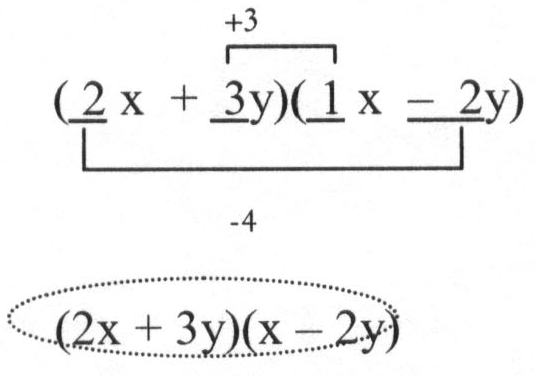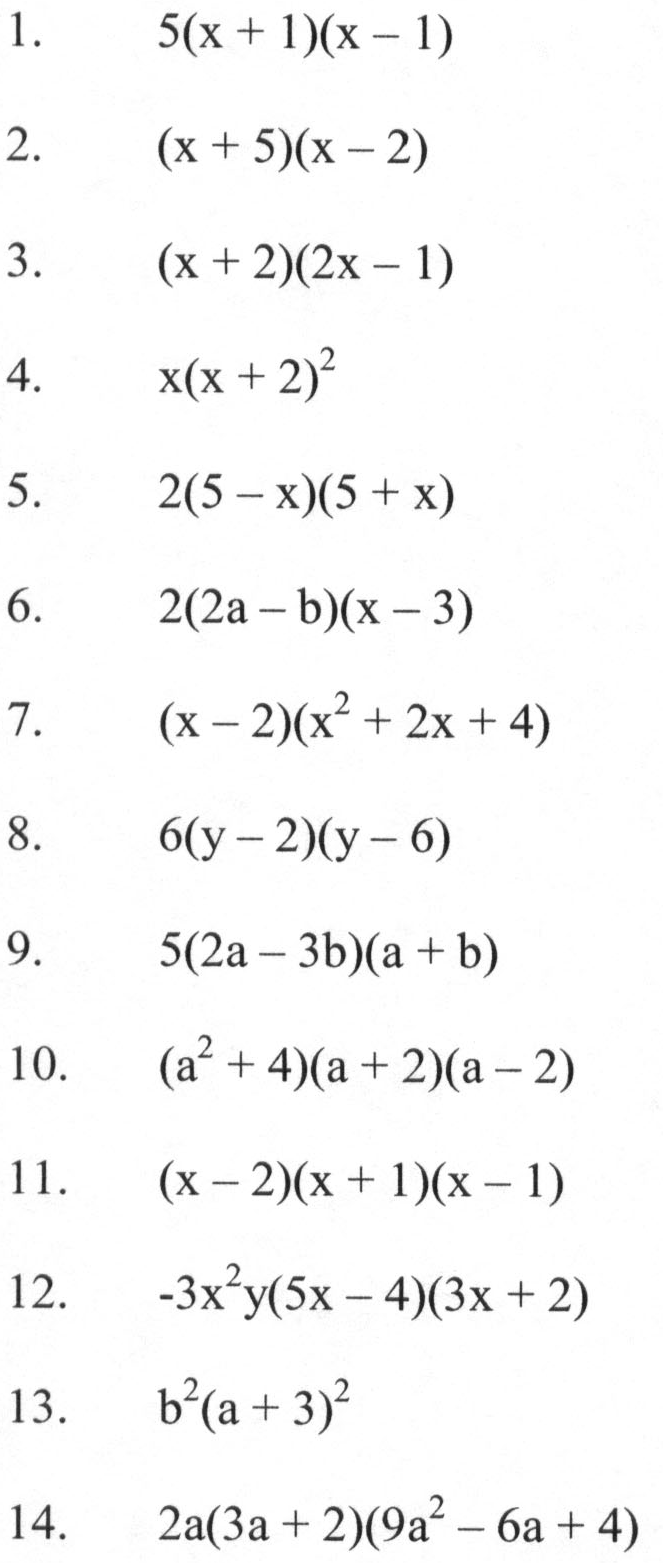Factoring Polynomials
III. Factor by Grouping(4 Terms)
Strategy: Group the four terms in pairs and find the GCF of each pair. Both pairs should then have
a common binomial factor.
Example 1:Factor 3ax-3ay-2bx+2by
3ax-3ay-2bx+2by
GCF of 1st group is 3a
GCF of 2nd group is -2b
(Note: If the two groups are separated by a subtraction always factor out a negative GCF from the
second group.)
Factoring each group yields 3a(x-y)-2b(x-y)
Both have a common binomial factor (x-y) which can be factored out leaving the other factor(3a-2b).
Solution: (x-y)(3a-2b)
Example 2: Factor 4X2-25X-21
Strategy: Notice!...this polynomial is the same as in section II and it doesn't have 4 terms. But,
if we replace the middle term-25x with the factor pair of ac from the list that adds to -25 we can
write this trinomial with 4 terms and solve by grouping .This is an alternative way of factoring a
trinomial where a≠1.
4x2-28x+3x-21
GCF of 1st group is 4x
GCF of 2nd group if 3
Factoring each group yields 4x(x-7)+3(x-7)
Both have a common binomial factou (x-7) which can be factored out leaving the other factor(4x-3)
Solution: (x-7)(4x-3)
Ⅳ. Special Cases (2 Terms)
i) Difference of Squares
Strategy: Check the binomial to see if it is a difference of squares.
A Difference of Squares A2-B2 factors into (A+B)(A-B)
TEST:
i) 1st and last terms must be perfect squares.
ii) Must be a subtraction.
NOTE: Besides a possible common factor, the Sum of Squares A2 + B2 is PRIME (not factorable).
Example: Factor 9x2-16
Test:
i) 1st term is 9x2
→(3x)2 and last term, is 16→
(4)2,both perfect squares with roots 3x and 4 as shown.
ii) are we subtracting? YES!
The binomial passes both test. It is a Difference of
Squares of the form
A2-B2 = (A+B)(A-B) where 3x
→A
and 4→
B
Solution: (3x+4)(3x-4)
ii) Difference OR Sum of Cubes
Strategy: Check the binomial to see if it is a difference of cubes or a sum of cubes.
A Difference of Cubes A3-B3 factors into
(A-B)(A2+AB+B2)
A Sum of Cubes A3+B3 factor into (A+B)(A2-AB+B2)
Note: The trinomial factor is often PRLME and cannot be factored further.
TEST:
i) 1st and last terms must be perfect cubes.
ii) Can be erther a subtraction OR an addition.
Example 1: Factor 27x3+8
Test:
i) 1st term is 27x3
→(3x)3 and last term is 8→
(2)3,both perfect cubes with roots 3x and 2 as shown.
ii) it is the sum of cubes.
The binomial is a Sum of Cubes of the form
A3+B3 = (A+B)(A2-AB+B2)
where 3x→
A and 2
→B
Solution: (3x+2)(9z2-6x+4)
Example 2: Factor 1-64x3
Test:
i) 1st term is 1
→(1)3 and last term is 64x3
→(4x)3, both perfect cubes with roots 1
and 4x as shown.
ii) it is the difference of cubes.
The binomial is a Difference of Cubes of the form
A3-B3 = (A-B)(A2+AB+B2)
where 1 →A
and 4x→
B
Solution: (1-4x)(1+4x+16x2)
WORKED EXAMPLES
1. Factor 16x4-1
(4x2)2-(1)2 Difference of
Squares
(4x2+1)(4x2-1) Another Difference of Squares!
(4x2+1)((2x)2-(1)2)
(4x2+1)(2x+1)(2x-1)
2. Factor 3x2+27
3(x2+9)
GCF
(X2+9) can NOT be factored further it is the Sum of Squares
which is prime.
3. Factor 8a3+27b3
(2a)3+(3b)3 Sum of Cubes
(2a+3b)(4a2-6ab+9b2)
4. Factor 2x2-xy-6y2
(_x_y)(_x_y) Factor pairs of ac = -12 that add to the
middle are 3 and -4

Practice Exercises
![]()
![]()
![]()
![]()
![]()
![]()
![]()
![]()
![]()
![]()
Answers to Practice Ecercises



